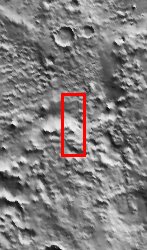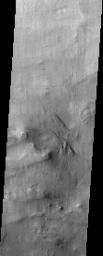
With a diameter of roughly 2000 km and a depth of over 7 km, the Hellas Basin is the largest impact feature on Mars. Because of its great depth, there is significantly more atmosphere to peer through in order to see its floor, reducing the quality of the images taken from orbit. This THEMIS image straddles a scarp between the Hellas floor and an accumulation of material at least a half kilometer thick that covers much of the floor. The southern half of the image contains some of this material. Strange ovoid landforms are present here that give the appearance of flow. It is possible that water ice or even liquid water was present in the deposits and somehow responsible for the observed landscape. The floor of Hellas remains a poorly understood portion of the planet that should benefit from the analysis of new THEMIS data.
Note: this THEMIS visual image has not been radiometrically nor geometrically calibrated for this preliminary release. An empirical correction has been performed to remove instrumental effects. A linear shift has been applied in the cross-track and down-track direction to approximate spacecraft and planetary motion. Fully calibrated and geometrically projected images will be released through the Planetary Data System in accordance with Project policies at a later time.
NASA's Jet Propulsion Laboratory manages the 2001 Mars Odyssey mission for NASA's Office of Space Science, Washington, D.C. The Thermal Emission Imaging System (THEMIS) was developed by Arizona State University, Tempe, in collaboration with Raytheon Santa Barbara Remote Sensing. The THEMIS investigation is led by Dr. Philip Christensen at Arizona State University. Lockheed Martin Astronautics, Denver, is the prime contractor for the Odyssey project, and developed and built the orbiter. Mission operations are conducted jointly from Lockheed Martin and from JPL, a division of the California Institute of Technology in Pasadena.

 Planetary Data System
Planetary Data System













